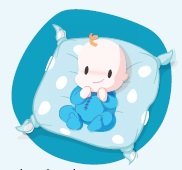An Amazing Natural Wonder
A new-born baby can see, hear and feel. By the age of five, a child can talk and ride a bike. How does this development happen? We don’t really understand the way language and thinking develop in the brain. Now scientists are using new technology to help them in their studies. They are discovering new information about the way a baby’s brain develops.
A study in 2010 showed that the experiences a child has in their first few years are important. These experiences affect the development of the brain. The study showed when children receive more attention, they often have higher IQs. Babies receive information when they see, hear and feel things. This information makes connections between different parts of the brain. There are a hundred trillion connections in the brain of a three-year-old child.
One experiment studied how new-born babies’ brains react to different sounds. The sounds were in different patterns. For example, the sounds “mu-ba-ba” make the pattern ‘A-B-B’. And the sounds mu-ba-ge make the pattern ‘A-B-C’. The results of the study showed that babies know the two patterns are different. Patterns are important in language. The order of words is important to grammar and meaning. For example, ‘John killed the bear’ doesn’t mean the same as ‘The bear killed John.’ Both sentences have the same words, but they are in a different order. The experiment shows that babies start to learn grammar rules from the beginning of their lives.

